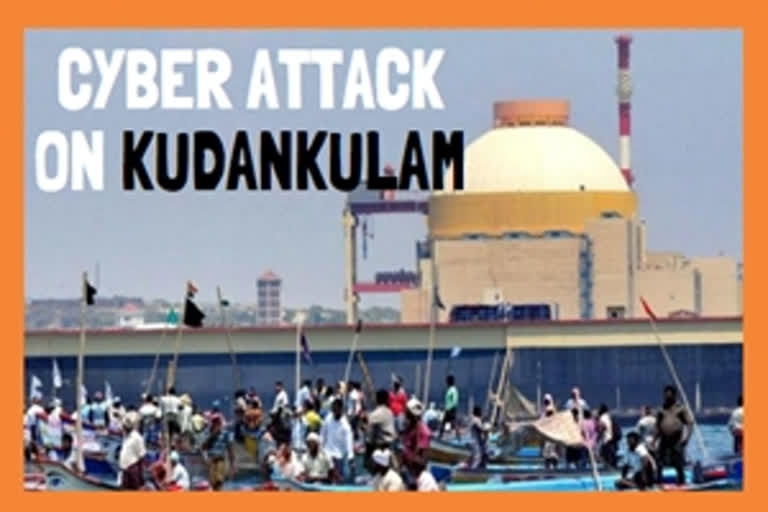‘Internet’ – a Warzone by itself!!
Pukhraj Singh, a cyber-expert of India has tweeted that the communications system of the Kudankulam Nuclear Power Board (KNPB) has been attacked by 'hackers' and that has created a nationwide sensation.
Lieutenant General Rajesh Pant, National Cyber Security Coordinator, said that the cyber-attack had taken place in September. As the news spread like wildfire across the news channels, on October 29, initially, KNPB Authorities denied the news and within the next 24 hours, the same organization agreed that there was, of course, an attack.
Nuclear Power Corporation of India Limited (NPCIL) announced on October 30 that the malware “Dtrack” had been found on the administrative network of the Kudankulam Nuclear Power Plant (KKNPP) in early September 2019. Dtrack is a kind of cyber weapon which is used to hack high-end computers. However, the technology department at the centre said they were safe from any kind of cyber threat since all their systems are “air-gapped and impossible to hack.” Systems are said to be “air-gapped” in the context of cybersecurity to describe isolated control processing technologies or systems that are not connected to the internet or external networks and are therefore considered safe. On the other hand, The Indian Space Research Organization (ISRO) has also received warnings of a Dtrack attack during the launch of Chandrayaan-2.
The attack highlights the cybersecurity flaws in India's most important security systems. Usually, it is the North Korean hacking gangs that use Dtrack malware. These gangs steal information and plan more cyber-attacks. This "malware" is used by hackers to steal key information from South Korea's financial services, banking and defence sectors. SA Bhardwaj, former chairman of India's Baba Nuclear Research Centre (BARC), said he received such ‘malware’ e-mails from the hackers. He is also the technical director of the Indian Atomic Power Company and a Thorium-based 'AHWR reactor' scientist! North Korea has for some time been interested in 'thorium-based nuclear technology' shifting its focus from 'uranium-based nuclear technology'. It is now concentrating on India, which is strong in thorium-based nuclear technology. Scientists from other countries who are doing research on thorium technology are also being observed by China. Likewise, it was reported that another key scientist from India, Anil Kakodkar, also received similar e-mails.
Scary North Korea
In modern times the range of battlefields has expanded even more. The war in the land, water, air and space has now reached the level of cyber-security. Cyber-attacks are a key component of security lapse, to disrupt the systems and create disruptions. India is one of the top three countries most vulnerable to attacks, according to a survey by cybersecurity firm Symantec. The US and China, which are among the top two in the list of affected countries, are ahead of India in taking cybersecurity measures. These countries have made arrangements to weaken their opponents. The US Cyber Command has discontinued Internet services to the 'Internet Research Agency' in St. Petersburg, Russia, as a precautionary measure in the 2018 governorship election for 36 states in the US. The event revealed America's undisputed dominance over the Internet. On May 2, 2019, Russia passed the Sovereign Internet Law. As a result, the country had the opportunity to operate the Internet with the help of its own 'DNS servers', separated from the existing internet system. Russia will soon test its own internet systems under the name of 'RUNET'!
India doesn’t seem to have learned from the efforts of countries like Russia to protect its security systems from the threat posed. Officials say a cyber-attack is unlikely as our key systems are in an "air gap" position. History says that this is no longer true when it comes to practice.
The US disrupted Iran's nuclear program. America targeted the four organizations that provide equipment to Iran’s ‘Nantej’ Uranium Refinery, through a digital weapon called Stuxnet. An employee of one of those companies connected his Pen Drive to a computer at the Nantes Nuclear Centre. Because of his action, around ‘984 gas central fuses' have been rendered useless. As a result, Iran is still unable to progress in the nuclear program. According to Kaspersky, a leading antivirus manufacturer, 90 per cent of corporate enterprises are vulnerable to cyber-attacks, only because of a human error; China is also stealing technology while targeting the US military subcontractors. This is because they do not have the capacity to make expensive cyber defences. China has previously carried out cyber-attacks on Indian 'National Security Council' systems. Hardware manufactured in China is also dangerous. Further, China has used the services of American based ‘Super Micro’s Networking Servers to attack America’s Elemental Organization – CIA. Because of this, the surveillance Drones quality of the pictures taken by the drones got affected. The main components of computers that use SuperMicro are made in China. Installing a bug of the size of rice grain in the main components prepared for the US Intelligence, by the SuperMicro computers, helped China do the cyber-theft, as per the info proclaimed by leading News Agency, Bloomberg. However, American sources denied that any such thing has ever happened. However, since then, the US had incorporated stringent laws on importing hardware products from China. The use of Chinese equipment in the Indian telecommunications industry has grown to an unavoidable rate. There are regulations that require companies in China to share matters of national security with their government.
